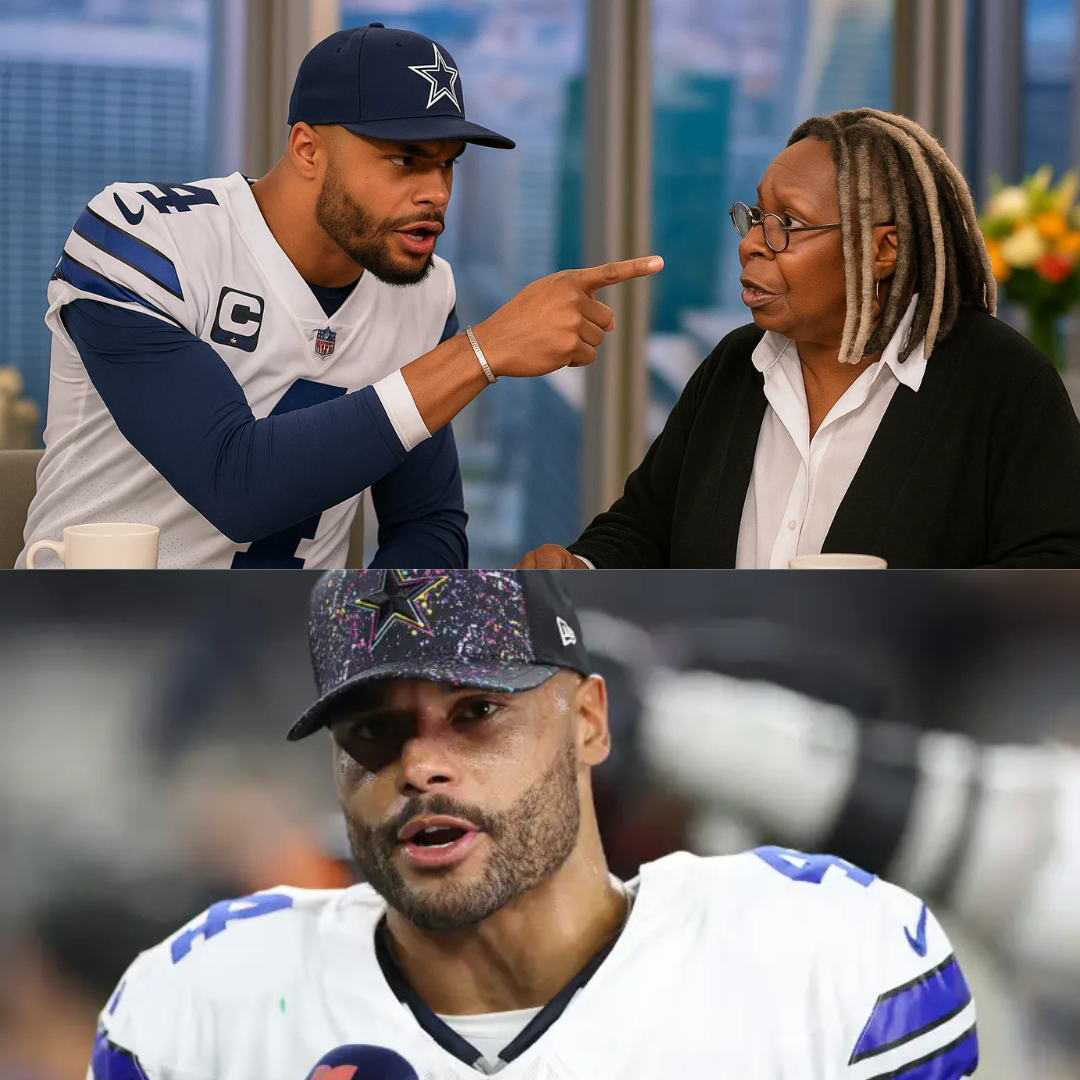The second Whoopi Goldberg screamed, “CUT IT! GET HIM OFF MY SET!”—it was already too late. Dak Prescott had just turned The View into ground zero for live-television chaos, and every camera was rolling.
Dak Prescott’s Alleged On-Set Clash With “The View” Ignites National Debate Over Civility and Live Television Boundaries

A viral video circulating across social platforms late Tuesday purports to show Dallas Cowboys quarterback Dak Prescott in a heated exchange with the hosts of “The View,” culminating in a dramatic walk-off that left the studio in apparent disarray. While the clip’s provenance and full context remain unverified, the episode—true or not—has already detonated a broader argument about civility, censorship, and how combustible live television can become when politics and celebrity collide.
According to posts sharing the video, the confrontation began after a pointed exchange about Prescott’s personal beliefs. In the clip, which appears to be recorded off a monitor and offers only a partial view, a voice resembling moderator Whoopi Goldberg can be heard calling for a cut as tensions rise. The camera angle then shifts to show Prescott addressing co-host Joy Behar with raised voice and emphatic gestures, insisting he would not be “lectured” and vowing to tell “the truth” as he sees it. Audience audio is largely indistinct, but the room noise swells as the moment peaks. The footage ends with Prescott pushing back his chair and moving out of frame.
Representatives for Prescott and “The View” did not immediately respond to requests for comment, and the show did not air a segment matching the viral clip on its official channels as of publication. Absent confirmation, media ethicists urged caution, noting how easily short, de-contextualized snippets can outrun facts. Still, the speed of the online reaction underscores the cultural volatility around high-profile confrontations on daytime platforms that are as much civic forums as entertainment products.
Supporters rallied behind the quarterback, casting him as a celebrity willing to challenge a panel they view as hostile to dissenting viewpoints. They praised what they called his refusal to be “managed” by television etiquette and framed the moment as a stand for authenticity over performance. Critics, meanwhile, argued that the outburst—if accurately depicted—crossed lines of respect, turning a conversation into a spectacle and reinforcing a corrosive pattern in which volume substitutes for persuasion.
Producers and crisis-communications veterans say the episode—real or misunderstood—illustrates the razor-thin margin for error on live or live-to-tape sets. Hot mics, overlapping crosstalk, and the pressure to deliver viral moments create conditions where a single escalation can overwhelm the rundown. Networks typically rely on delay buffers, segment boundaries, and seasoned moderators to keep debates inside guardrails. But when tempers rise and star wattage intensifies, those controls can falter in seconds.
The incident also reopens an old question with new urgency: what do audiences want from daytime debate shows? For some, confrontation reads as accountability; for others, it feels like theater that leaves viewers more entrenched and less informed. The marketplace has rewarded both models—measured conversations with room to breathe, and high-temperature clashes engineered for clip culture.
Until verified footage or official statements surface, the viral clip remains an uncorroborated snapshot that says as much about the audience as the participants. Yet its resonance is unmistakable. Whether Dak Prescott actually “blew the doors off” a daytime format or merely became the latest subject of internet telephone, the takeaway is the same: in an era of instantaneous sharing and polarized expectations, the line between discussion and detonation can be a single sentence—and the court of public opinion convenes long before the credits roll.
Commanders Get Big Update on Terry McLaurin Injury Timeline Before ‘MNF’

Wide receiver Terry McLaurin will miss a third straight game because of a quad injury, but fortunately for the Washington Commanders, his return may not be far off.

NFL Network’s Tom Pelissero reported Sunday that McLaurin could be back in Week 7.
“There have been no setbacks,” Pelissero said. “He’s just working his way through his rehab. McLaurin does have a chance to be back next week.”
The Commanders (3-2) host the Chicago Bears on Monday Night Football.
McLaurin Making Progress in Practice
McLaurin sat out most of training camp while pushing for a new contract. The two-time Pro Bowler had 10 catches for 149 yards over the first three games before hurting his quad in a Week 3 win over the Las Vegas Raiders.
After not practicing all week, McLaurin was officially ruled out on Saturday by head coach Dan Quinn.
While there’s optimism that McLaurin will be ready to go for a key NFC East matchup in Week 7 against the Dallas Cowboys, he’ll still need to show progress in practice over the next few days in order to get the green light to play.
During a portion of Saturday’s practice, McLaurin, 30, was seen running sprints on a side field — an encouraging sign as he works his way back.
Coming off his fifth consecutive 1,000-yard receiving season, McLaurin signed a three-year, $96 million extension in August.
Commanders Expected to Be Without Multiple Receivers
The Commanders also ruled out receiver Noah Brown (groin/knee), while Deebo Samuel (heel) did not practice Thursday or Saturday but is expected to play Monday despite being listed questionable.
Samuel has been the Commanders’ most productive receiver since being acquired in an offseason trade with the San Francisco 49ers. The All-Pro has been targeted a team-high 38 times, resulting in 30 catches for 300 yards and three touchdowns. He’s also rushed for 46 yards and a score.
Brown, who famously caught a Hail Mary touchdown to beat the Bears last October, hurt his groin in a Week 2 loss to the Green Bay Packers but only returned to practice this week. Evidently, he’ll need more time before he can fully return to action.
“He did have a good week in the individual work, but he’s just not there yet,” Quinn said, via ESPN’s John Keim.
With McLaurin and Samuel still sidelined, Luke McCaffrey is shaping up to be the No. 2 receiver behind Samuel.



